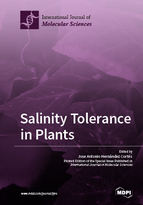Salinity Tolerance in Plants
A special issue of International Journal of Molecular Sciences (ISSN 1422-0067). This special issue belongs to the section "Molecular Plant Sciences".
Deadline for manuscript submissions: closed (28 February 2019) | Viewed by 116793
Special Issue Editor
Interests: antioxidant systems; ASC-GSH cycle; hormone profile; hydrogen peroxide; reactive oxygen species; redox signaling; proteomic; seed biology; seed dormancy
Special Issues, Collections and Topics in MDPI journals
Special Issue Information
Dear Colleagues,
Salinity stress is one of the major abiotic stresses that results in significant losses in agricultural crop production, particularly in arid and semi-arid climates. Therefore, it is of vital importance to know the mechanisms of tolerance to salinity in order to obtain plants that are more tolerant to this abiotic stress, necessary for more sustainable and more productive agriculture under a scenario of climate change.
Salt stress is first perceived by the root system impairing plant growth in the short term by inducing osmotic stress. In the long term, salinity-induced ion toxicity due to a nutrient imbalance in the cytosol. In addition, salt stress is also manifested as an oxidative stress at the subcellular level, mediated by ROS. All these responses to salinity contribute to deleterious effects on plants. Plants tolerant to NaCl implement a series of adaptations to acclimate to salinity, including morphological, physiological, biochemical and molecular changes.
The aim and scope of this Special Issue is to encourage the publication of review and/or experimental research dealing with physiological, biochemical and molecular aspects related to salt-tolerance mechanisms in plants, including in vitro culture conditions.
Dr. José Antonio Hernandez Cortes
Guest Editor
Manuscript Submission Information
Manuscripts should be submitted online at www.mdpi.com by registering and logging in to this website. Once you are registered, click here to go to the submission form. Manuscripts can be submitted until the deadline. All submissions that pass pre-check are peer-reviewed. Accepted papers will be published continuously in the journal (as soon as accepted) and will be listed together on the special issue website. Research articles, review articles as well as short communications are invited. For planned papers, a title and short abstract (about 100 words) can be sent to the Editorial Office for announcement on this website.
Submitted manuscripts should not have been published previously, nor be under consideration for publication elsewhere (except conference proceedings papers). All manuscripts are thoroughly refereed through a single-blind peer-review process. A guide for authors and other relevant information for submission of manuscripts is available on the Instructions for Authors page. International Journal of Molecular Sciences is an international peer-reviewed open access semimonthly journal published by MDPI.
Please visit the Instructions for Authors page before submitting a manuscript. There is an Article Processing Charge (APC) for publication in this open access journal. For details about the APC please see here. Submitted papers should be well formatted and use good English. Authors may use MDPI's English editing service prior to publication or during author revisions.
Keywords
- Adaptive mechanisms;
- Biochemical adaptations;
- Biostimulants and Salt-Stress Response;
- Gas Exchange;
- Gene expression;
- Plant Hormones;
- Proteomic;
- Molecular responses to salinity
- Nitro-oxidative stress;
- Oxidative stress;
- Osmotic regulation;
- Physiological responses to salinity
- Photosynthesis;
- Water relations;
- Salt tolerance mechanisms
- Salt tolerance under in vitro conditions







